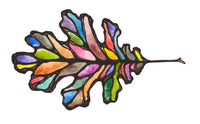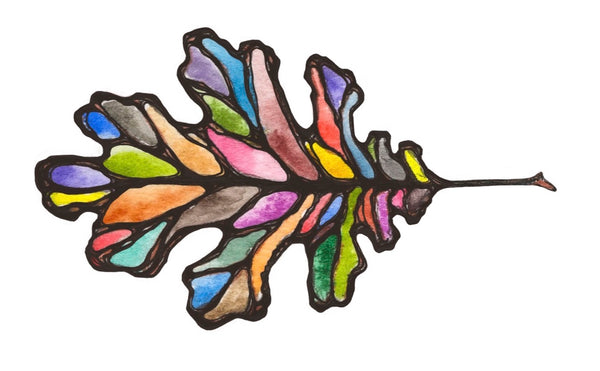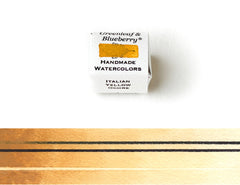Phthalocyanine Warm Green Watercolor Paint, Full Pan
Greenleaf & Blueberry Professional Handmade Watercolors
Color Overview
| Color Name | Phthalocyanine Warm Green |
| Pigment | Phthalocyanine Warm Green |
| Pigment Index No. | PG36 |
| Chemical Formula |
C₃₂H₁₂Cl₁₀Br₆CuN₈ |
| Series No. | Series 4 |
| Lightfastness Rating | 5/5 Very Lightfast |
| Toxicity | 1/5 No Known Toxicity |
| Hue | Green Category |
| Chroma | 5/5 High Chroma |
| Transparency | 1/5 Very Transparent |
| Pigment Type | Synthetic |
| Granulation | Yes |
| Value Range | 4/5 Wide Range |
| Tinting Strength | 5/5 High Strength |
| Staining | Somewhat Staining |
| Flocculation | 2/5 Dispersing |
| Variegation | Some |
Swatches
Color behavior assessments and descriptions are of course somewhat subjective, your perception being determined by your watercoloring experience. We offer this information with the intent of giving you an accurate idea of how a color will look and handle so that you can determine if it is a good fit for your palette and painting practice.
SCROLL DOWN FOR INFORMATION ABOUT HOW TO REACH EACH TYPE OF SWATCH
| Combination Swatch |
 |
| Gravity Wash Swatch |
 |
| Value Scale Swatch |
 |
Color Description
Our Phthalocyanine Warm Green (PG36) is an intense green that leans more towards yellow than Phthalocyanine Cool Green (PG7). It also possesses a nearly complete value range, almost reaching black at its most concentrated. Additionally, it also displays some granulation, along with a hint of variegation. A very interesting color!
Its characteristics are generally typical of Phthalocyanine pigments, in terms of tinting strength and value range. However, its ability to granulate sets it a bit apart. Particle size is very fine and and it disperses nicely. Its intensity can make it a bit of a challenge to control if you are unfamiliar with modern synthetic pigments.
This color is is an excellent choice for a convenience color (to save you the time of mixing a similar hue). You can use it to quickly mix up a Sap Green hue by adding in a touch of yellow and a dash of orange or brown.
Each of the above swatches have been painted onto Arches Cold Pressed 140 lb. watercolor paper.
Color Story
The family of Phthalocyanine pigments, generally comprising a range of blues and greens, was fist discovered by accident in Scotland in 1928, and the first Phthalocyanine Green pigment became available for sale in 1938. Popular greens of the day such as Emerald Green and Verdigris were highly toxic and fugitive.
The chemical structure of a Phthalocyanine pigment is based on a ring system called a porphin, which has a number of notable parallels found in nature, such as chlorophyll (the green pigment in plants that absorbs light) and hemoglobin (blood's red chromoprotein). Where a Phthalocyanine pigment contains copper at the center of its molecular porphin rings, chlorophyll contains magnesium and hemoglobin contains iron.
This pigment is valued not only because of its lack of toxicity and its high permanence, but also because of its clear, bright hue. Phthalocyanine Green is seen by many artists as a desirable, higher chroma alternative to Viridian, though some artists still prefer the more subtle tones of the older pigment.
Swatch Descriptions
Combination Swatch
This swatch demonstrates:
- Opacity: Compare the two black lines, the top lines is drawn over the swatch and the bottom one is under the swatch. The more the bottom line has disappeared, the more opaque the color.
- Staining: The white line at the bottom of the swatch was lifted out. The whiter the line, the less staining the color.
- Value Range: Color is painted from most concentrated (at left) to least concentrated at right. The closer a color is to black at most concentrated, the wider its value range. (All watercolors painted onto white paper can be diluted to complete transparency, or white.)
Gravity Wash Swatch
A Gravity Wash Swatch is made by pre-wetting the paper, then holding it vertically at an angle, and applying paint from left to right at the very top of the wetted area.
This swatch demonstrates:
-
Granulation: Granulation display is influenced both by pigment particle size and behavior determined by chemical composition. Granulating colors are recognizable in Gravity Washes through their patterned and textured appearance.
-
Flocculation: Flocculation is the tendency for a color's pigment particles to cling together or be attracted to one another. Dispersion is the opposite. A flocculating color is recognizable in a Gravity Wash by a "jellyfish" appearance with the downward movement of the pigment resembling tentacles, while a dispersing color more resembles a distant rainstorm, as is the case with French Red Ochre.
-
Variegation: Variegation is the tendency for a color's pigment to express itself as more than one hue, usually as a result of a range of pigment particle sizes. In a Gravity Wash, pigment particles have an opportunity to settle by size a bit, with the smaller particles getting carried further to the edges of where the color travels. If you only notice one hue in a gravity wash, then it is likely not a variegating color.
- Tinting Strength: It can be difficult to determine tinting strength in controlled color swatches. Because Gravity Washes are less controlled, you can get a more unvarnished look at a color, enabling you to assess characteristics you usually only catch glimpses of when painting. Colors that appear very dark, intense, and that cover more of the wash area have a more intense tinting strength, while colors that appear more faint and taper out before reaching the bottom of the swatch have a weaker tinting strength. We have rated French Red Ochre as moderate tinting strength (3/5), though it can be argued that it is closer to a 4.
Value Scale Swatch
This swatch is painted in layers, starting with the lightest/least concentrated, and letting each layer dry before the next more concentrated layer is added. The leftmost and most concentrated layer is applied at a maximum concentration, which is generally not how watercolors are most often used, however this swatch is designed to display the full value range of a color.
This swatch demonstrates:
Value Range: Value range is a colors range from darkest (most concentrated) to lightest (least concentrated/most diluted). Value range is arguably one of the most important aspects of any watercolor. This type of swatch allows you to hold up a magnifying glass to that characteristic.
Our Pans
We work with standard plastic Full Pans. These are durable and lightweight as well, and fit into most commercial travel watercolor boxes.
Our Full Pans measure: 3cm x 1.9cm x 1cm
Full Pans can be thought of as the portable equivalent to a tube of watercolor paint. They are twice the size of a Half-Pan and hold a whole lot of color. This size is a great choice for artists who enjoy working large. Not only does this size pan hold more paint, it also has a greater surface area which can accommodate much larger brushes. This size is also a wonderful way to carry your favorite colors. If you have used up a Half-Pan and wish to replenish a palette staple, a Full Pan can be a nice next-step. Palettes of Full Pans also make excellent flexible studio palettes; they are large enough to be used in a home studio or table-top set-up while allowing you to close up the set and take it on the road.
More Information
- Overview of Pigments
- What Makes Our Colors Different
- How To Pick Colors & Create Your Perfect Watercolor Palette
Other Items You Might Find Useful For Watercolor Painting
Please be aware that every monitor and screen displays colors a little differently. We have done our very best to show our colors as they appear in person and on paper.
**Please Note**: These colors are NOT intended for children. Half-Pans are small and therefore a choking hazard. Please use only as intended.
All images and descriptions are copyrighted by Greenleaf & Blueberry®
© Greenleaf & Blueberry LLC 2011-2025
Description: An intense, green that leans more towards yellow than Phthalocyanine Cool Green. Wide value range, intense tinting strength, some natural variegation.



Further information about our watercolor paints is available here.
Please be aware that every monitor and screen displays colors a little differently. We have done our very best to show our colors as they appear in your hand.
**Please Note**: These colors are NOT intended for children. Half-Pans are small and therefore a choking hazard. Please use only as intended.












